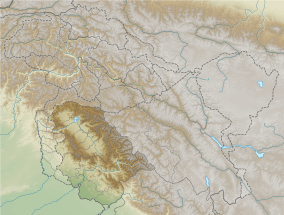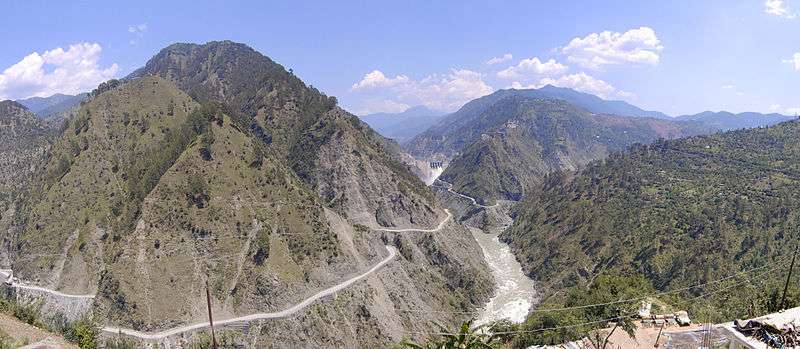Baglihar Dam
Baglihar Dam (Hindi: Baglihār Bāndh), also known as Baglihar Hydroelectric Power Project, is a run-of-the-river power project on the Chenab River in the Ramban district of the Indian union territory of Jammu and Kashmir. This project was conceived in 1992, approved in 1996 and construction began in 1999. The project was estimated to cost US$1 billion. The project consists of two-stage of 450MW each, the first stage of the project was completed in 2008-09 and was dedicated to the nation by the Prime Minister Manmohan Singh of India. Whereas, the second stage of the project was completed in 2015-16, and was subsequently dedicated to the nation by the Prime Minister Narendra Modi of India.[2][3]
| Baglihar Dam | |
|---|---|
 Location of Baglihar Dam in Jammu and Kashmir | |
| Country | India |
| Location | Ramban district, Jammu and Kashmir, India |
| Coordinates | 33°09′43″N 75°19′40″E |
| Construction began | 1999 |
| Opening date | 2008 |
| Dam and spillways | |
| Type of dam | Gravity |
| Impounds | Chenab River |
| Height | 144 m (472 ft) |
| Length | 317 m (1,040 ft) |
| Elevation at crest | 843 m (2,766 ft) |
| Dam volume | 1,800,000 m3 (63,566,400 cu ft) |
| Spillway type | Chute type |
| Spillway capacity | 16,500 m3/s (582,692 cu ft/s)[1] |
| Reservoir | |
| Total capacity | 395,950,000 m3 (321,002 acre⋅ft)[2] |
| Active capacity | 32,560,000 m3 (26,397 acre⋅ft) above 836 m msl |
| Surface area | 8,079,000 m2 (1,996 acres) |
| Normal elevation | 840 m msl (FRL or full pond level) |
| Power Station | |
| Commission date | Stage I: 2005 Stage II: 2008 |
| Hydraulic head | 130 m (427 ft) (gross) |
| Turbines | Stage I: 3 x 150 MW Francis-type Stage II: 3 x 150 MW Francis-type |
| Installed capacity | Stage I: 450 MW Stage II: 450 MW Total: 900 MW |
Design controversy and verdict
After construction began in 1999, Pakistan claimed that design parameters of the Baglihar project violated the Indus Water Treaty of 1960. The treaty provided India with exclusive control over three eastern rivers while granting Pakistan exclusive control over three western rivers, including Chenab River. However, it contained provisions for India to establish run-of-the-river power projects with limited reservoir capacity and flow control needed for feasible power generation. Availing this provision, India established several run-of-the-river projects, with Pakistan objecting to these. Also in the case of the Baglihar and Kishanganga Hydroelectric Plants, Pakistan claimed that some design parameters were too lax than were needed for feasible power generation and provided India with excessive ability to accelerate, decelerate or block the flow of the river, thus giving India a strategic leverage in times of political tension or war.
During 1999-2004 India and Pakistan held several rounds of talks on the design of projects, but could not reach an agreement. After the failure of talks on 18 January 2005, Pakistan raised six objections to the World Bank, a broker and signatory of Indus Water Treaty. In April 2005 the World Bank determined the Pakistani claim as a ‘Difference’, a classification between the less serious ‘Question’ and more serious ‘Dispute’, and in May 2005 appointed Professor Raymond Lafitte, a Swiss civil engineer as a neutral expert, to adjudicate the difference.
Lafitte declared his final verdict on 12 February 2007,[4][5] in which he upheld some minor objections of Pakistan, declaring that pondage capacity is reduced by 13.5%, height of dam structure be reduced by 1.5 meter and power intake tunnels be raised by 3 meters, thereby limiting some flow control capabilities of the earlier design. However, he rejected Pakistani objections on height and gated control of spillway declaring these conformed to engineering norms of the day. India had already offered Pakistan similar minor adjustments for it to drop its objection. The Indus Waters Treaty of 1960 divided the Indus river — into which the Chenab flows — between the two countries and bars India from interfering with the flow into Pakistan while allowing it to generate electricity. However, the key issue that any dam constructed by India should be strictly run of the river was rejected. Pakistan government expressed its disappointment at the final outcome. Both parties (India and Pakistan) have already agreed that they will abide by the final verdict.
The verdict acknowledged India's right to construct 'gated spillways' under Indus water treaty 1960. The report allowed pondage of 32.56 million cubic meters against India's demand for 37.5 million cubic metres. The report also recommended reducing the height of freeboard from 4.5 m to 3.0 m. The verdict permitted drawdown flushing to prevent silt accumulation in the reservoir which has enhanced the life of the reservoir to above 80 years. Without drawdown flushing, the reservoir would have been completely silted in 13 years period by 2017.[6]
On 1 June 2010 India and Pakistan resolved the issue relating to the initial filling of Baglihar dam in Jammu and Kashmir with the neighbouring country deciding not to raise the matter further. The decision arrived at the talks of Permanent Indus Commissioners of the two countries. "The two sides discussed the issue at length without any prejudice to each other's stand...Indian and Pakistani teams resolved the issue relating to the initial filling of Baglihar dam after discussions," sources said. Pakistan also agreed not to raise the issue further.

See also
- Ratle Hydroelectric Plant – under construction upstream
- Kishanganga Hydroelectric Plant
- Salal Hydroelectric Power Station
- Rivers of Jammu and Kashmir
References
- Tan, edited by Martin Wieland, Qingwen Ren, John S.Y. (2004). New developments in dam engineering. London: Balkema. pp. 315–316. ISBN 0-415-36240-7.CS1 maint: extra text: authors list (link)
- "Pakistan-India Relations" (PDF). Pakistani Institute of Legislative Development and Transparency (PILDAT). Archived from the original (PDF) on 24 July 2011. Retrieved 13 June 2011.
- PM’s opening remarks at the Press Conference, Government of India, 10 October 2008.
- "Baglihar Hydroelectric Plant: Expert Determination" (PDF). Retrieved 15 April 2018.
- "Baglihar Hydroelectric Plant: drawings annexure to Expert Determination" (PDF). Retrieved 15 April 2018.
- "Baglihar Hydroelectric Plant Case Documents Expert Determination" (PDF). Retrieved 15 April 2018.
External links
- "The Indus Waters Treaty 1960 (with annexes)" (PDF). United Nations. Retrieved 30 October 2018.
- Baglihar Dam cleared by neutral expert, Government of India press release, 12 February 2007.